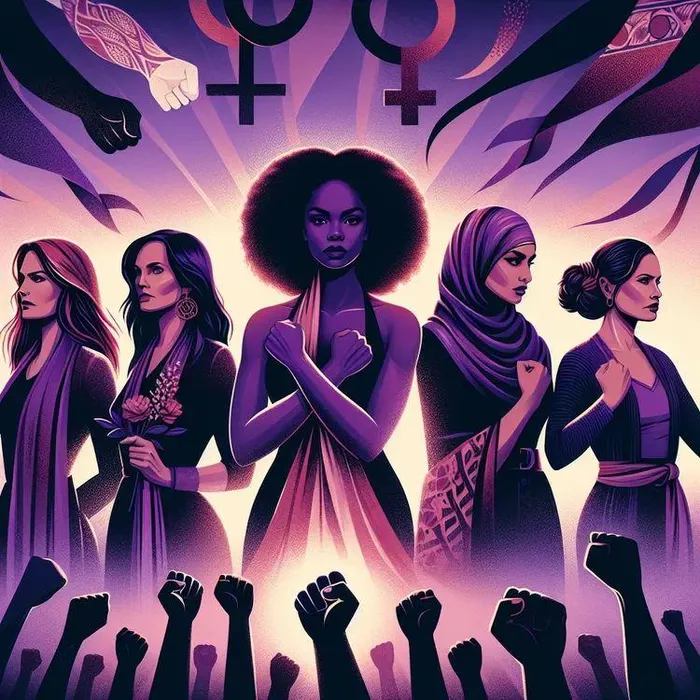Why the colour purple is a powerful symbol in the fight against gender-based violence

As the G20 Summit approaches, South Africa is witnessing a powerful display of solidarity as women nationwide call for a national shutdown, turning the country purple in protest and demand for change.
Image: Ron
Purple is more than just a colour. It tells a story, stands as a symbol and makes a statement.
Over the years, this bold shade has come to represent wisdom, dignity, courage and resistance.
Today, purple is at the heart of a movement that goes beyond social media. It has become a call for justice, unity and change, especially in the fight against gender-based violence (GBV).
Purple has held deep meaning from ancient royalty to today’s activism.
But why is it the colour chosen by movements for women’s justice and equality?
Historically, collective action using this colour has sparked significant change, uniting individuals under a common banner of resistance and hope.
It stands as a beacon of solidarity that reminds us how powerful we can be when we come together.
How can we use its power to create real change in a world that sometimes ignores women’s voices?
Purple has always been associated with power and transformation.
Centuries ago, it signified wealth and royalty due to the rarity of its dye. But in modern times, purple transitioned into a colour of defiance and solidarity.
The suffragettes of the early 20th century adopted purple as a symbol of justice and dignity in their fight for women’s right to vote.
In the 1960s and the '70s, second-wave feminists revived its use, tying it to the broader women’s liberation movement.
Today, purple is worn and displayed during Domestic Violence Awareness Month, observed in October, honouring victims and survivors while raising awareness for GBV.
But it’s not just about the history. Purple’s symbolism is personal, spiritual and empowering.
In colour psychology, it represents creativity, independence and ambition. Its spiritual side aligns with transformation and wisdom, a fitting emblem for movements seeking to challenge entrenched societal norms.

Women For Change has called for a nationwide shutdown on Friday, November 21.
Image: Women For Change
Building on its history of transformation, purple now takes on a vital role in South Africa today: resistance.
Women For Change, a civil society group, has spearheaded a powerful purple-themed movement to confront the country’s epidemic of GBV and femicide.
Over 5,500 women were murdered in South Africa in just one year, according to recent police reports, a 33.8% increase.
The femicide rate is six times higher than the global average. Behind every number is a life, a story, and a family shattered by violence.
Women For Change has called for a nationwide shutdown on Friday, November 21. Their demands are simple yet profound: declare GBV a national disaster.
To amplify their message, they’ve turned to the colour purple, urging supporters to change their profile pictures to purple, wear black in mourning and participate in symbolic actions that disrupt daily life.
After the shutdown, maintaining momentum is crucial.
Activists are encouraged to contact local officials, demanding stronger policies and accountability measures.
Organising local events and forums to discuss ongoing strategies can also help sustain pressure and progress.
Here’s how to join the purple movement:
💜 Change your profile picture to purple: Amplify the movement online and keep the conversation alive.
💜 Wear black: A simple yet powerful way to symbolise mourning and resistance.
💜 Step away from work: Both paid and unpaid labour for one day, highlight the invisible work women shoulder daily.
💜 Lie down at noon: Join the 15-minute standstill, lying down for one minute for each of the 15 women murdered daily in South Africa.
💜 Don’t spend: Withdraw from the economy for a day to demonstrate women’s economic power.
This isn’t just a South African issue; this is a global call to action. From Zimbabwe to Namibia, Kenya to Korea, women are using purple to say, “Enough is enough".
The movement is proof that digital platforms can mobilise real change, and purple is its unifying force.
Purple’s power isn’t limited to GBV. It has become a unifying colour for multiple causes:
- LGBTQ+ rights: Lavender, a shade of purple, was reclaimed by the LGBTQ+ community after the “Lavender Scare,” a campaign of persecution in mid-20th-century America. Today, purple represents visibility and solidarity, particularly during Spirit Day, which stands against bullying of LGBTQ+ youth.
- Addiction recovery: Purple symbolises collective action and individual responsibility in the fight against addiction.
- Disability rights: In some contexts, purple has come to represent the disability rights movement.
Purple’s versatility speaks to its universal appeal. It’s a colour of visibility, justice and resilience qualities that resonate across movements and borders.
Despite the overwhelming crisis of GBV, South Africa’s National Disaster Management Centre (NDMC) recently declined a petition to declare it a national disaster.
According to Dr Ellias Sithole, the head of the NDMC, the issue, while severe, does not meet the legal definition of a disaster under the Disaster Management Act.
Instead, the government insists that existing mechanisms, like the National Strategic Plan on GBVF, are sufficient to address the crisis.
But activists disagree. They argue that the current systems are failing to protect women and hold perpetrators accountable.
The purple movement is a direct response to this inaction, a refusal to accept the status quo.
∎ In South Africa, anyone experiencing GBV can access support through several key services. The Gender‑Based Violence Command Centre is available 24/7 at 0800 428 428 or through a Please Call Me to *120*7867# from any cell phone.